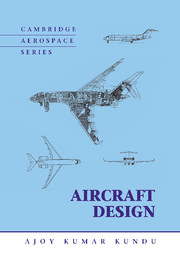Book contents
- Frontmatter
- Contents
- List of Symbols and Abbreviations
- Preface
- Road Map of the Book
- 1 Introduction
- 2 Methodology to Aircraft Design, Market Survey, and Airworthiness
- 3 Aerodynamic Considerations
- 4 Aircraft Classification, Statistics, and Choices for Configuration
- 5 Aircraft Load
- 6 Configuring Aircraft
- 7 Undercarriage
- 8 Aircraft Weight and Center of Gravity Estimation
- 9 Aircraft Drag
- 10 Aircraft Power Plant and Integration
- 11 Aircraft Sizing, Engine Matching, and Variant Derivative
- 12 Stability Considerations Affecting Aircraft Configuration
- 13 Aircraft Performance
- 14 Computational Fluid Dynamics
- 15 Miscellaneous Design Considerations
- 16 Aircraft Cost Considerations
- 17 Aircraft Manufacturing Considerations
- Appendix A Conversion
- Appendix B International Standard Atmosphere
- Appendix C Aerofoils
- Appendix D Case Studies
- Appendix E Tire Data
- References
- Index
2 - Methodology to Aircraft Design, Market Survey, and Airworthiness
Published online by Cambridge University Press: 05 June 2012
- Frontmatter
- Contents
- List of Symbols and Abbreviations
- Preface
- Road Map of the Book
- 1 Introduction
- 2 Methodology to Aircraft Design, Market Survey, and Airworthiness
- 3 Aerodynamic Considerations
- 4 Aircraft Classification, Statistics, and Choices for Configuration
- 5 Aircraft Load
- 6 Configuring Aircraft
- 7 Undercarriage
- 8 Aircraft Weight and Center of Gravity Estimation
- 9 Aircraft Drag
- 10 Aircraft Power Plant and Integration
- 11 Aircraft Sizing, Engine Matching, and Variant Derivative
- 12 Stability Considerations Affecting Aircraft Configuration
- 13 Aircraft Performance
- 14 Computational Fluid Dynamics
- 15 Miscellaneous Design Considerations
- 16 Aircraft Cost Considerations
- 17 Aircraft Manufacturing Considerations
- Appendix A Conversion
- Appendix B International Standard Atmosphere
- Appendix C Aerofoils
- Appendix D Case Studies
- Appendix E Tire Data
- References
- Index
Summary
Overview
This chapter is concerned with how aircraft design projects are managed in a company. It is recommended that newly initiated readers read through this chapter because it tackles an important part of the work – that is, to generate customer specifications so that an aircraft configuration has the potential to succeed. A small part of the course work starts in this chapter. The road to success has a formal step-by-step approach through phases of activities and must be managed.
The go-ahead for a program comes after careful assessment of the design with a finalized aircraft configuration having evolved during the conceptual study (i.e., Phase 1). The prediction accuracy at the end of Phase 1 must be within at least ±5%. In Phase 2 of the project, when more financing is available after obtaining the go-ahead, the aircraft design is fine-tuned through testing and more refined analysis. This is a time-and cost-consuming effort, with prediction accuracy now at less than ±2 to ±3%, offering guarantees to potential buyers. This book does not address project-definition activities (i.e., Phase 2); these are in-depth studies conducted by specialists and offered in specialized courses such as CFD, FEM, Simulink, and CAM.
This book is concerned with the task involved in the conceptual design phase but without rigorous optimization. Civil aircraft design lies within a verified design space; that is, it is a study within an achievable level of proven but leading-edge technology involving routine development efforts.
- Type
- Chapter
- Information
- Aircraft Design , pp. 19 - 42Publisher: Cambridge University PressPrint publication year: 2010



